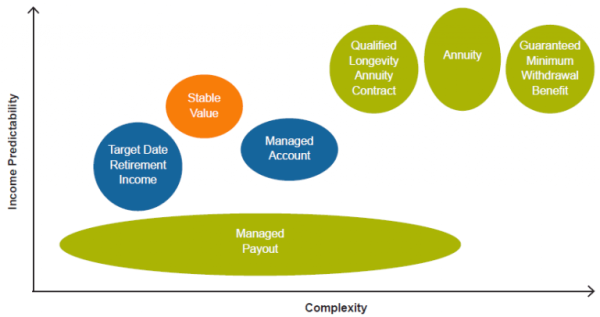It may be hard to believe, but the 401(k)—the most popular type of defined contribution (DC) plan—turned 40 this year. Up to now, the retirement industry has focused on improving the “accumulation phase” of DC plans. But as DC plans enter middle age, the retirement industry should start thinking more about the “distribution phase,” when participants are drawing down the assets they have accumulated over their working lives.
In this post, we set out some of the options plan sponsors can offer participants for the distribution phase, if they wish to retain retiree/terminated participant assets. Sponsors should evaluate the breadth of choices they wish to offer retirees, alongside the level of fees and complexity, in making a determination of which choices to offer.
Managed Accounts
With these, a participant (or recordkeeper) provides participant-level information (age, contribution level, outside assets, etc.) and the managed account provider takes discretion over the account to build a customized asset allocation, often using the core fund lineup. Many managed accounts now feature drawdown solutions as an integral part of the service, generally taking the existing fund lineup and designing an asset allocation to withdraw assets at a certain rate. They can also further help those in retirement strategize around taxes and Social Security issues.
These solutions, though, carry the same limitations that face managed accounts more broadly, chief of which are cost and engagement. In order to truly harness the value, participants must engage and supply data. Cost also remains a hurdle, with some solutions charging up to 60 basis points per year in addition to the underlying asset management fees.
The Universe of Options for the Distribution Phase

Stable Value
Such funds use insurance wraps around a generally intermediate bond portfolio to provide a stable NAV. Stable value funds typically offer a yield premium above money market funds.
But wrap contracts often forbid plan sponsors from offering “competing options,” which could include low-duration bond funds, TIPS options, and even managed accounts. And in a rapidly rising interest rate environment, the crediting rate for stable value will typically lag the increase in money market yields due to the longer duration of the underlying portfolio.
Target Date Options
While much of the conversation with target date funds (TDFs) focuses on the accumulation side of the glidepath, providers can differentiate themselves from a crowded field by communicating the drawdown protection of their TDFs and the portfolio construction of their funds for the post-retirement set.
Few providers currently discuss the yield for their “income” vintages. These vintages are often a given series’ most conservative allocation, and they are not widely understood or marketed. The industry would benefit from information such as the yield and distribution frequency/flexibility inherent in these income funds. By doing so, providers and plan sponsors could leverage the power of these default options to facilitate asset drawdowns.
Annuities
Despite their long track record and ubiquity, annuities remain stuck in the mud. On the plan sponsor side, the major concerns involve the absence of a safe harbor for annuity selection as well as lack of recordkeeper portability. If guaranteed products cannot be ported from one recordkeeper to another, a plan can either eliminate the guaranteed product (and participants must forgo the premiums they have paid) or remain with a suboptimal recordkeeper.
Longevity insurance represents another possible avenue for an annuity product to gain traction. A qualified longevity annuity contract (QLAC) creates a “longevity safety net” and also allows those in retirement to define a specific drawdown period—the time between when they retire (e.g., 65), and the age when the QLAC provides annuity income (e.g., 80 – 85). QLACs can also address the issue of cognitive decline by providing a guaranteed stream of income later in life, when participants may have trouble making financial decisions.
Managed Payouts
Managed payout funds typically contain a multi-asset mix and offer a recommended distribution rate to help retirees manage their withdrawals. The underlying mix across the market varies from all-equity to all-fixed income.
Plan sponsors can select from options that run the gamut in terms of volatility and the level of recommended payout. These options also vary in whether the design intends for the withdrawal to be funded from yield and returns, or by eating into the principal as well. The appeal of payout funds lies in their simplicity and liquidity; many of them are available as mutual funds. Without guarantees, the messy recordkeeping portability issues do not crop up. The fund can cleanly be sold without any loss of premiums but this must be balanced with decreased income predictability.
Ultimately the success of such funds will depend heavily on the communication that accompanies them. In a participant-directed plan, participants need to know what funds the plan offers and which of those are the most appropriate for the distribution phase of their plan experience. These payout funds in particular require participants to set up the distribution with their recordkeeper.


